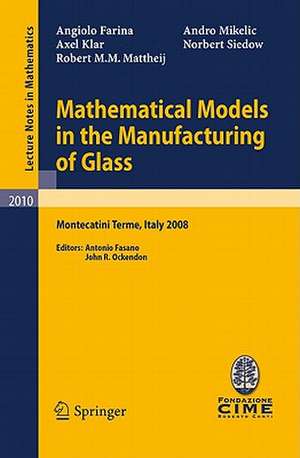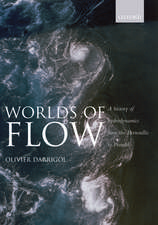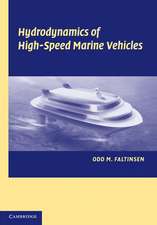Mathematical Models in the Manufacturing of Glass: C.I.M.E. Summer School, Montecatini Terme, Italy 2008: Lecture Notes in Mathematics, cartea 2010
Autor Angiolo Farina Editat de Antonio Fasano Autor Axel Klar, Robert M.M. Mattheij, Andro Mikeli´c, Norbert Siedowen Limba Engleză Paperback – 8 dec 2010
Din seria Lecture Notes in Mathematics
- 17%
 Preț: 360.43 lei
Preț: 360.43 lei -
 Preț: 459.92 lei
Preț: 459.92 lei -
 Preț: 121.41 lei
Preț: 121.41 lei -
 Preț: 175.68 lei
Preț: 175.68 lei -
 Preț: 197.00 lei
Preț: 197.00 lei -
 Preț: 279.76 lei
Preț: 279.76 lei -
 Preț: 477.66 lei
Preț: 477.66 lei - 17%
 Preț: 361.89 lei
Preț: 361.89 lei -
 Preț: 252.37 lei
Preț: 252.37 lei -
 Preț: 353.99 lei
Preț: 353.99 lei -
 Preț: 138.88 lei
Preț: 138.88 lei -
 Preț: 152.61 lei
Preț: 152.61 lei -
 Preț: 116.67 lei
Preț: 116.67 lei -
 Preț: 102.77 lei
Preț: 102.77 lei - 17%
 Preț: 365.53 lei
Preț: 365.53 lei -
 Preț: 396.76 lei
Preț: 396.76 lei - 17%
 Preț: 362.15 lei
Preț: 362.15 lei -
 Preț: 396.13 lei
Preț: 396.13 lei -
 Preț: 357.80 lei
Preț: 357.80 lei - 17%
 Preț: 362.31 lei
Preț: 362.31 lei -
 Preț: 403.81 lei
Preț: 403.81 lei - 17%
 Preț: 361.73 lei
Preț: 361.73 lei -
 Preț: 499.87 lei
Preț: 499.87 lei -
 Preț: 457.03 lei
Preț: 457.03 lei -
 Preț: 395.91 lei
Preț: 395.91 lei -
 Preț: 459.00 lei
Preț: 459.00 lei -
 Preț: 487.57 lei
Preț: 487.57 lei -
 Preț: 424.01 lei
Preț: 424.01 lei -
 Preț: 487.57 lei
Preț: 487.57 lei -
 Preț: 330.55 lei
Preț: 330.55 lei -
 Preț: 325.75 lei
Preț: 325.75 lei -
 Preț: 350.30 lei
Preț: 350.30 lei -
 Preț: 331.31 lei
Preț: 331.31 lei -
 Preț: 408.37 lei
Preț: 408.37 lei -
 Preț: 328.25 lei
Preț: 328.25 lei -
 Preț: 421.28 lei
Preț: 421.28 lei -
 Preț: 276.08 lei
Preț: 276.08 lei -
 Preț: 424.60 lei
Preț: 424.60 lei -
 Preț: 422.05 lei
Preț: 422.05 lei -
 Preț: 505.01 lei
Preț: 505.01 lei -
 Preț: 422.05 lei
Preț: 422.05 lei -
 Preț: 274.93 lei
Preț: 274.93 lei -
 Preț: 335.16 lei
Preț: 335.16 lei -
 Preț: 422.27 lei
Preț: 422.27 lei -
 Preț: 497.49 lei
Preț: 497.49 lei -
 Preț: 272.81 lei
Preț: 272.81 lei -
 Preț: 428.04 lei
Preț: 428.04 lei -
 Preț: 376.22 lei
Preț: 376.22 lei -
 Preț: 427.10 lei
Preț: 427.10 lei -
 Preț: 325.92 lei
Preț: 325.92 lei
Preț: 417.81 lei
Nou
Puncte Express: 627
Preț estimativ în valută:
79.96€ • 83.17$ • 66.01£
79.96€ • 83.17$ • 66.01£
Carte tipărită la comandă
Livrare economică 15-29 aprilie
Preluare comenzi: 021 569.72.76
Specificații
ISBN-13: 9783642159664
ISBN-10: 3642159664
Pagini: 227
Ilustrații: XI, 227 p.
Dimensiuni: 155 x 235 x 20 mm
Greutate: 0.34 kg
Ediția:2011
Editura: Springer Berlin, Heidelberg
Colecția Springer
Seriile Lecture Notes in Mathematics, C.I.M.E. Foundation Subseries
Locul publicării:Berlin, Heidelberg, Germany
ISBN-10: 3642159664
Pagini: 227
Ilustrații: XI, 227 p.
Dimensiuni: 155 x 235 x 20 mm
Greutate: 0.34 kg
Ediția:2011
Editura: Springer Berlin, Heidelberg
Colecția Springer
Seriile Lecture Notes in Mathematics, C.I.M.E. Foundation Subseries
Locul publicării:Berlin, Heidelberg, Germany
Public țintă
ResearchCuprins
Mathematical modelling of glass forming processes.- Radiative heat transfer and applications for glass production processes.- I. Radiative heat transfer and applications for glass production processes.- II. Nonisothermal flows and fibres drawing.
Textul de pe ultima copertă
This volume presents a review of advanced technological problems in the glass industry and of the mathematics involved. It is amazing that such a seemingly small research area is extremely rich and calls for an impressively large variety of mathematical methods, including numerical simulations of considerable complexity. The problems treated here are very typical of the field of glass manufacturing and cover a large spectrum of complementary subjects: injection molding by various techniques, radiative heat transfer in glass, nonisothermal flows and fibre spinning. The book can certainly be useful not only to applied mathematicians, but also to physicists and engineers, who can find in it an overview of the most advanced models and methods.
Caracteristici
Includes supplementary material: sn.pub/extras













